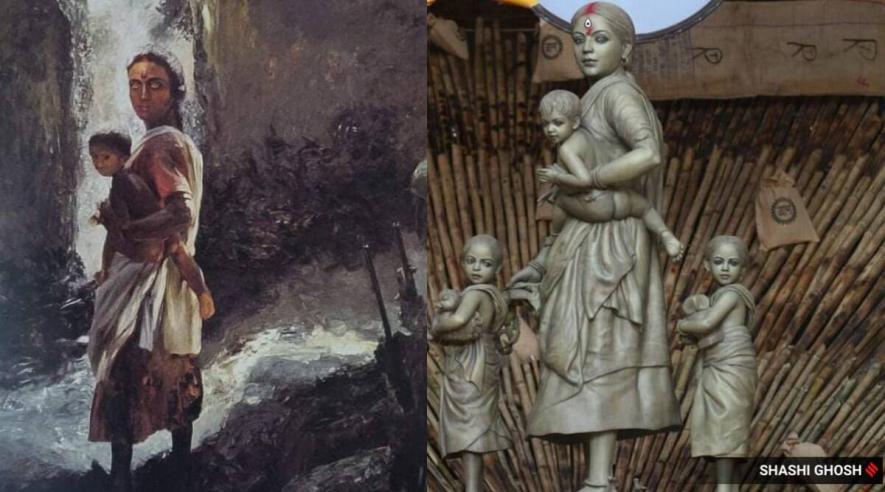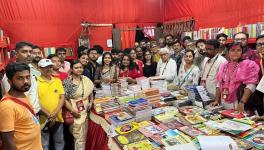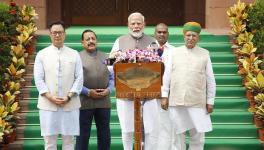Durga with a Heart and Looks

“This year, Durga did not have the heart to dress up in resplendent attire, deck up in glossy make-up or wear dazzling jewellery,” says Rintu Das, the artist who created an idol of the goddess as a migrant labourer, which has created a nation-wide buzz. The idol, which depicts a “dressed-down” deity in a plain colourless sari, with her children Lakshmi and Saraswati in tow and tiny tot Kartik perched on her hip, is reminiscent of the scenes when soon after the pandemic-induced lockdown started earlier this year, hundreds of thousands of working people stuck in different parts of the country walked back to their distant villages.
Das, 46, an alumnus of the Government College of Art and Craft, Calcutta, is known in the city for his imaginative and sensitive portrayals of themes drawn from ordinary life while designing Durga Puja pandals. This year, the migrant crisis was his cue, and his idols are on display at a pandal in Behala, a large locality of south-west Kolkata. “Every day, whenever we turned on the TV news, we saw heart-rending visuals of men, women and children, hungry, thirsty and tired marching on ahead and I was convinced mother Durga wanted me to highlight their pain, their suffering.”
Das decided he would recreate these scenes for Barisha, a neighbourhood club in Behala with which he has been associated for three years. “I had a completely different design planned which I had even begun to work on. But things went topsy-turvy when the Coronavirus-related lockdown was announced and a big question mark hung over whether the celebrations would take place this year at all,” he says.
For a while, Barisha nearly cancelled the programme, but now residents are relieved and elated that the pandal is in their neighbourhood. “We didn’t think it would be possible,” says Animesh Chakraborty, a member of the club. “First there was a funds crunch because of the pandemic,” he says. The budget for a pandal, including decorations, ranges from Rs.50 to Rs.65 lakh, according to Barisha, but this year it crashed to less than Rs.10 lakh. “But Rintu da [Das] told us that that’s all he needed,” says Chakraborty. “And he reassured us saying come what may, I will ensure we have a protima [idol].”
The idol, which is finished in fibreglass, was first created in clay and then cast in a mould of Plaster of Paris. Das collected jute sacks (used to store rice) as props. The Durga idol and her entourage of children are shown reaching for food grains and other “relief” material packed in these tiny bags.
Videos of the idol have gone viral on social media, bringing Behala’s residents cheer—and also attracting some criticism. Says Subhanjan Ghosh, a communications executive, who lives in the area, “Behala has a mix of people from different social strata and the pandals here depict themes which appeal to a [wide] cross section.”
According to Ananth Taran Ghoshal, a temple priest, the decision to depict Durga as a working class woman rather than an inaccessible goddess could find acceptability because of the city’s cosmopolitanism. “Whether Behala or any other location, if it were not for an element of liberalism in Kolkata residents, religious orthodoxy or even social pressure would be difficult for them to surmount.”
Das concurs: “Kolkata and West Bengal have hundreds of pandals during the pujas, and there is always competition to outshine one another in creativity.” He says, “The locality of a Puja pandal does not necessarily play a key part in determining the themes that a club chooses, it does to a certain extent determine the success it will have or the acceptability it will have.”
Many Behala residents insist the figure of migrant workers could have come up anywhere in Kolkata during the Puja, as there is a propensity to depict themes based on current affairs. In some parts of rapidly-expanding Behala live school-teachers, office-goers, and other gentrified or gentrifying citizens, many in parts of which are flooded during the rainy season. Every year, the house of a former mayor of Kolkata is the first to get flooded, and those who know this fact often make jokes about it. Yet Behala is a middle class neighbourhood—not where migrant workers live, but most of it not posh either.
And so, when Das experimented with the theme of younger generations’ neglect of their lonely, elderly parents, whom they abandon in order to pursue lucrative careers elsewhere at a pandal at a middle class neighbourhood in the city last year, it too was a huge success. “A young woman came with tears in her eyes, saying she would go to the old age home where she had kept her mother the very next day and bring her home. It touched my heart.”
Not that Das’ latest depiction of Durga has not generated controversy. Social media is flooded with praise for the unique idea, but a number of people say the face of the idol indicates well-fed satiety, which does not go well with any depiction of undernourished migrant workers. Some lament that a more “aesthetically appealing” model has been used even to convey the marginalised. Rather than an emaciated figure, a well-fed substitute has been made, they say. Indeed, some observers say Durga and her children looked “too pretty”. Others have noted an uncannily similarity between Das’ sculpture and “Dorpomoyee”, which means she who retains her pride and is the title of a painting by the famous artist Bikash Bhattacharjee, in which a gaunt woman with a toddler at her hip, looking over her shoulder exactly as Das’ Durga does.
Das replies to his critics with a rhetorical question: “Just because she is a migrant worker and poor, does not mean she cannot have an attractive or arresting face, does it?” To counter allegations of imitation, the Barisha Club, on its Facebook Page, has posted photos of Bhattacharya’s painting, and acknowledged his work as the inspiration.
Das explains that Ganesh was placed at the feet of Durga, his mother, below the others because he “wanted to show him as a playful, laughing child, oblivious of the suffering, which is how children often respond to crisis.” That is also why he has made Lakshmi and Saraswati carry their mascots, owl and swan respectively, as if they are toys.
The deity was inaugurated by West Bengal chief minister Mamata Banerjee and certainly one reason for launching pandals is to gain support from voters as elections approach. Banerjee also did her best to allow puja celebrations, but now the court has said no visitors can go right inside the installations. A parallel fact is that Durga puja is one more aspect of the state’s culture the BJP has simply not been able to tap into. Bengal has a history of Communist rule for 35 years and that is one reason why the kind of religious politics that takes place in the Hindi heartland does not happen here, limiting the BJP’s reach and hold over the state.
In any case, Das has made for himself a place in modern history. His creation will not be immersed in water, as is the norm with clay idols. Instead, the entire installation is to be displayed at a museum as a representation of unique subaltern art.
The author is a freelance journalist. The views are personal.
Get the latest reports & analysis with people's perspective on Protests, movements & deep analytical videos, discussions of the current affairs in your Telegram app. Subscribe to NewsClick's Telegram channel & get Real-Time updates on stories, as they get published on our website.
























